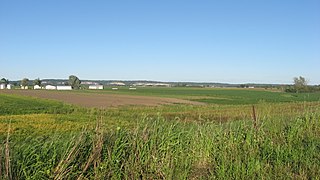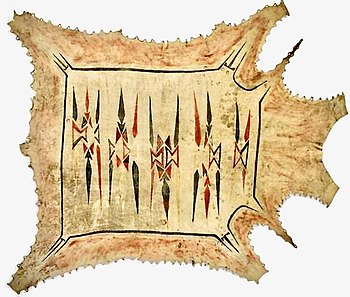
The Miami are a Native American nation originally speaking one of the Algonquian languages. Among the peoples known as the Great Lakes tribes, they occupied territory that is now identified as north-central Indiana, southwest Michigan, and western Ohio. The Miami were historically made up of several prominent subgroups, including the Piankeshaw, Wea, Pepikokia, Kilatika, Mengakonkia, and Atchakangouen. In modern times, Miami is used more specifically to refer to the Atchakangouen. By 1846, most of the Miami had been forcefully displaced to Indian Territory. The Miami Tribe of Oklahoma are the federally recognized tribe of Miami Indians in the United States. The Miami Nation of Indiana, a nonprofit organization of self-identified descendants of Miamis who were exempted from removal, have unsuccessfully sought separate recognition.

Kaskaskia is a village in Randolph County, Illinois. Having been inhabited by indigenous peoples, it was settled by France as part of the Illinois Country. It was named for the Kaskaskia people. Its population peaked at about 7,000 in the 18th century, when it was a regional center. During the American Revolutionary War, the town, which by then had become an administrative center for the British Province of Quebec, was taken by the Virginia militia during the Illinois campaign. It was designated as the county seat of Illinois County, Virginia, after which it became part of the Northwest Territory in 1787. Kaskaskia was later named as the capital of the United States' Illinois Territory, created on February 3, 1809. In 1818, when Illinois became the 21st U.S. state, the town briefly served as the state's first capital until 1819, when the capital was moved to more centrally located Vandalia.

The Beaver Wars, also known as the Iroquois Wars or the French and Iroquois Wars were a series of conflicts fought intermittently during the 17th century in North America throughout the Saint Lawrence River valley in Canada and the Great Lakes region which pitted the Iroquois against the Hurons, northern Algonquians and their French allies. As a result of this conflict, the Iroquois destroyed several confederacies and tribes through warfare: the Hurons or Wendat, Erie, Neutral, Wenro, Petun, Susquehannock, Mohican and northern Algonquins whom they defeated and dispersed, some fleeing to neighbouring peoples and others assimilated, routed, or killed.

The Kaskaskia were one of the indigenous peoples of the Northeastern Woodlands. They were one of about a dozen cognate tribes that made up the Illiniwek Confederation, also called the Illinois Confederation. Their longstanding homeland was in the Great Lakes region. Their first contact with Europeans reportedly occurred near present-day Green Bay, Wisconsin, in 1667 at a Jesuit mission station.

The Illinois Country — sometimes referred to as Upper Louisiana —was a vast region of New France claimed in the 1600s in what is now the Midwestern United States. While those names generally referred to the entire Upper Mississippi River watershed, French colonial settlement was concentrated along the Mississippi and Illinois Rivers in what is now the U.S. states of Illinois and Missouri, with outposts on the Wabash River in Indiana. Explored in 1673 from Green Bay to the Arkansas River by the Canadien expedition of Louis Jolliet and Jacques Marquette, the area was claimed by France. It was settled primarily from the Pays d'en Haut in the context of the fur trade, and in the establishment of missions from Canada by French Catholic religious orders. Over time, the fur trade took some French to the far reaches of the Rocky Mountains, especially along the branches of the broad Missouri River valley. The French name, Pays des Ilinois, means "Land of the Illinois [plural]" and is a reference to the Illinois Confederation, a group of related Algonquian native peoples.

The Peoria are a Native American people. They are enrolled in the federally recognized Peoria Tribe of Indians of Oklahoma headquartered in Miami, Oklahoma.

Starved Rock State Park is a state park in the U.S. state of Illinois, characterized by the many canyons within its 2,630 acres (1,064 ha). Located just southeast of the village of Utica, in Deer Park Township, LaSalle County, Illinois, along the south bank of the Illinois River, the park hosts over two million visitors annually, the most for any Illinois state park.

Chief Illiniwek was the symbol of the University of Illinois Urbana-Champaign (UIUC), associated with the university's intercollegiate athletic programs, from October 30, 1926, to February 21, 2007. Chief Illiniwek was portrayed by a student to represent the Illiniwek, the state's namesake, although the regalia worn was from the Sioux. The student portraying Chief Illiniwek performed during halftime of Illinois football and basketball games, as well as during women's volleyball matches.

The Algonquians are one of the most populous and widespread North American native language groups. They historically were prominent along the Atlantic Coast and in the interior regions along Saint Lawrence River and around the Great Lakes. This grouping consists of the peoples who speak Algonquian languages.

The Wea were a Miami-Illinois-speaking Native American tribe originally located in western Indiana. Historically, they were described as either being closely related to the Miami Tribe or a sub-tribe of Miami.
The Tamaroa were a Native American people in the central Mississippi River valley of North America, and a member of the Illiniwek or Illinois Confederation of 12 or 13 tribes. The name "Tamaroa" is a derivative of the word tamarowa meaning "cut tail" in Illiniwek and relates to a totemic animal such as bear or wildcat. An Algonquian-speaking group, like the rest of the Illiniwek, they lived on both sides of the Mississippi River in the area of the confluence with the Illinois and Missouri Rivers. Tamaroan culture is presumed to be similar to that of the Kaskaskia, Peoria, and other Illinois tribes.
Miami-Illinois, also known as Irenwa or Irenwe, is an indigenous Algonquian language spoken in the United States, primarily in Illinois, Missouri, Indiana, western Ohio and adjacent areas along the Mississippi River by the Miami and Wea as well as the tribes of the Illinois Confederation, including the Kaskaskia, Peoria, Tamaroa, and possibly Mitchigamea. The Myaamia (Miami) Nation of Oklahoma and the Miami Nation of Indians of the State of Indiana still practice and use their native heritage to teach young and old so they can keep their traditional language alive.

The Grand Village of the Illinois, also called Old Kaskaskia Village, is a site significant for being the best documented historic Native American village in the Illinois River valley. It was a large agricultural and trading village of Native Americans of the Illinois confederacy, located on the north bank of the Illinois River near the present town of Utica, Illinois. French explorers Louis Joliet and Father Jacques Marquette came across it in 1673. The Kaskaskia, a tribe of the Illiniwek people lived in the village. It grew rapidly after a French mission and fur trading post were established there in 1675, to a population of about 6,000 people in about 460 houses. Around 1691 the Kaskaskia and other Illiniwek moved further south, abandoning the site due to pressure from an Iroquois invasion from the northeast.
The Mitchigamea or Michigamea or Michigamie were a tribe in the Illinois Confederation. Not much is known about them and their origin is uncertain. Originally they were said to be from Lake Michigan, perhaps the Chicago area. Mitchie Precinct, Monroe County in Southwestern Illinois takes its name from their transient presence nearby, north of the French Fort de Chartres in the American Bottom along the Mississippi. One of their villages in the American Bottom, inhabited from 1730 until 1752, is one of the region's premier archaeological sites; it is known as the "Kolmer Site".
Jacques Gravier, SJ was a French Jesuit missionary in the New World. He founded the Illinois mission in 1696, where he ministered to the several tribes of the territory. He was notable for his compilation of the most extensive dictionary of Miami-Illinois among those made by French missionaries. In 1705 he was appointed superior of the mission and he died in 1708.

Fort Crevecoeur was the first public building erected by Europeans within the boundaries of the modern state of Illinois and the first fort built in the West by the French. It was founded on the east bank of the Illinois River, in the Illinois Country near the present site of Creve Coeur, a suburb of Peoria, Illinois, in January 1680. It was destroyed on April 16, 1680 by members of La Salle's expedition, who mutinied and abandoned it, fearful of being attacked by the Iroquois League as the Beaver Wars extended into the area.
The Cahokia were an Algonquian-speaking Native American tribe and member of the Illinois Confederation; their territory was in what is now the Midwestern United States in North America.

Le Grand Champ is an alluvial floodplain, also called a bottom, extending along the Mississippi River in Ste. Genevieve County, Missouri.

The Kolmer Site is an archaeological site in the far southwest of the U.S. state of Illinois. Located near Kaskaskia and Prairie du Rocher in western Randolph County, it lies at the site of an early historic Indian village from the French period. Because it occupies a critical chronological and cultural position, it has been given national recognition as a historic site.















